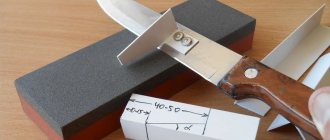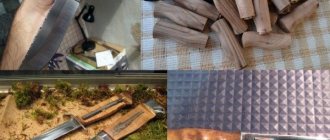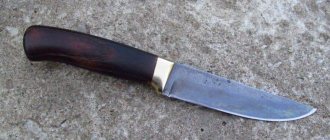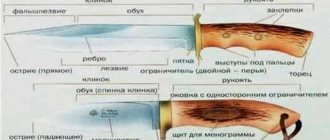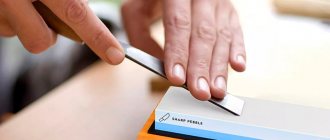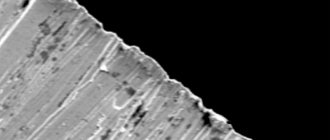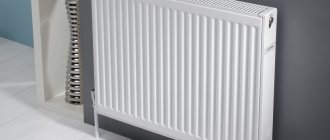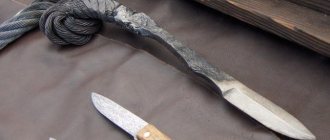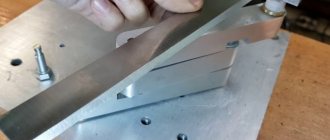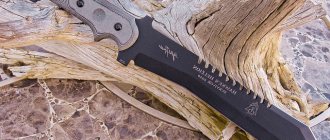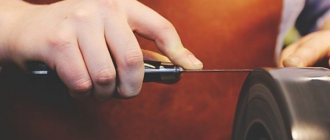Wood
As with other wood products, the first advantage is the attractive appearance of such handles, and other characteristics common to all types are comfort for the hand, non-slip and low weight. True, there are quite a lot of differences between different types of wood.
- Boxwood, ironwood and ebony are the most used species - they are quite dense and wear-resistant, although they are not the best in terms of resistance to moisture. To increase moisture resistance, they are treated with oils, waxes or synthetic varnishes.
- Maple absorbs less moisture due to the fact that it has smaller pores; its strength is slightly lower than that of the rocks from the previous paragraph.
- Amboyn is one of the most expensive types of wood, durable and wear-resistant. When processing, it requires sealing minor defects in the form of shells.
- Bocote is a fine-pored, expensive wood native to Mexico. Very wear-resistant option.
- Wenge lends itself well to processing and has the famous beautiful natural pattern on the cut.
Wenge, one of the most beautiful types of wood, is also easy to process
- Bubinga, a tree native to West Africa, is extremely resistant to frost and heat, as well as mechanical damage. It has an interesting natural pattern, which they try to emphasize with oils rather than painting over it with varnishes.
- Thuja is good for making knife handles that come into contact with moisture. By itself, it secretes a lot of resins, which fill its pores; because of this, it has a high resistance to moisture. One of the disadvantages of thuja is the ability to quickly dry out and dry out (the latter case concerns poorly made handles).
- Walnut is rarely used for making handles, as it is too soft and prone to deformation. Nevertheless, knives with similar handles can still be found.
Types of wood for knife handles
To make knife handles, a large number of different types of wood are used, such as: Karelian birch, bubinga, wenge, stabilized hornbeam, padauk, elk horn, sapele, rosewood, birch bark and others. Any knife, even the best one, no matter how strong it is. It will be of little use for practical use if it has a bad handle. The formula for a good knife is a blade made of reliable and durable steel + a handle that fits comfortably in the hand and is made from the right material. For fishing, a knife with a birch bark handle is good, but for hunting, a wooden handle is better; for winter hunting, a knife made of horn will be cold on your hand without gloves. Let's take a closer look at the most popular types of wood.
Stabilized hornbeam imitates the texture of ebony wood. Ebony is one of the most valuable wood species growing in Africa. The high price is due both to the rarity of the species and to the fact that the wood has a large amount of sapwood (the layer of wood between the bark and the core), which allows only about 30% of the trunk to be used for products. In addition, ebony wood is prone to cracking, which is unacceptable for a knife handle. Thanks to impregnation with resins, black hornbeam imitates the texture of ebony and is not subject to cracking; in addition, hornbeam handles are extremely durable due to the high density of wood, which makes it an ideal material for making black knife handles.
In the photo (from left to right): iron wood, hornbeam block stabilized with resins, handles made of stabilized hornbeam.
Wenge is a tropical type of wood often used to make knife handles, not only because of its beautiful structure, but also because of its physical properties. Characterized by an extremely coarse texture with straight veins. It has extremely high resistance to shock loads, which will allow the handle to last as long as the knife blade. Rot resistant. The color range can vary greatly from golden brown to very dark brown with black veins; blanks from the core of the barrel are used to make knife handles.
Bubinga or otherwise African rosewood has a beautiful and extremely rich structure with beautiful pinkish and red veins. Both the core and sapwood of the tree are suitable for handles; in this case, the only difference will be the color, the sapwood is several shades lighter. An extremely dense (from 800 to 960 kg/m3) and heavy type of wood, but bubinga handles look very solid and solid. Not prone to cracking, resists moisture and fungus well.
Paduk is an extremely common tree in the southern hemisphere. One of the most water-resistant types of wood (in contact with soil, it can last an average of 25 years), it is well suited for fishing and hunting knives in rainy and wet weather, as it does not slip in the hand, even when wet.
In the photo (from left to right) the handles are made of: bubinga, wenge, paduka.
One of the most ancient materials for making knife handles is bone and animal horns. Like wood, it is a natural material; elk antler . It is a very difficult material to process compared to wood, but the game is worth the effort, the handles are exclusive and different from each other; if a huge number of handles can be made from a tree trunk, then a very limited number can be made from the horn of one elk.
When ordering a knife with a handle made of elk horn, you should understand that it may differ slightly from what you see in the photo, just like with fingerprints, no two people are exactly alike.
The only disadvantage of this material can perhaps be considered only the inconvenience of using it when hunting in winter; in the cold, the horn handle gets very cold and it will be very uncomfortable to hold it with bare hands.
Birch bark is practical and convenient as a material for a handle; its main advantage is that the handle does not slip in the hand, even if a large amount of water gets on it. Well, of course, birch is our native wood, and not wood from Africa and the tropics. Birch bark typically contains a large amount of tar, which gives it disinfecting properties and protects it from rotting; no parasites or fungi will take root on birch bark. An extremely good material for fishing knives, a small knife with a birch bark handle can stay afloat once in the water.
Sapale is another type of wood native to Africa. An extremely beautiful textured palette ranging from light pink to reddish brown. It is not prone to cracking and has high hardness, from 4.1 to 4.5 Brinell units. All types of wood presented on the site are perfect for making knife handles, and to a greater extent, the choice of a knife with a specific handle has aesthetic significance, depending on your personal preferences.
In the photo (from left to right) the handles are made of: elk horn, birch bark, sapele.
The handles can also be made of several types of wood, with “senditch” inserts next to the knife guard, or in the middle of the handle. All types of wood presented on the site are perfect for making knife handles, and to a greater extent, the choice of a knife with a specific handle has aesthetic significance, depending on your personal preferences.
Cap
Burl handles are also one of the most common. If you have ever seen a spherical growth on a tree, sometimes quite large, you should know that this is a burl. The wood fibers inside it are arranged randomly, which looks very beautiful when cut. In addition, burl is denser than ordinary wood, which has a good effect on its performance characteristics: firstly, it absorbs less water, and secondly, it is much more resistant to mechanical damage.
Burl handle – increased strength characteristics and unique natural pattern
One of the disadvantages of the material is difficulty in processing - again due to density.
Birch bark
Stacked handles made of birch bark are also a common occurrence. You can especially often see such material on a fishing or hunting knife. Birch bark resists rot well and is comfortable in the palm of your hand in any weather. An additional advantage is buoyancy. If a knife with a birch bark handle accidentally “dives” into the water, it will not sink to the bottom immediately: a light handle will prevent this from happening. Other pleasant qualities of the inlaid birch handle include good thermal and electrical insulation, and one of the disadvantages is flammability.
Stacked birch bark handles are very popular among fishermen and hunters - such a knife will not “dive” to the bottom of the reservoir
Many people choose such handles for their convenience: they fit very well in the hand.
Fruit trees
Good handles are made from apple, pear, cherry or plum. But it’s not worth cutting down fruit trees to make knife handles out of them. But if you need to cut down a bad or non-fruit-bearing tree on your site, then it would be a sin not to use such good, and most importantly free, material. As a last resort, you can cut the wood into blanks and sell it to knife makers.
Leather
The manufacturing principle for a leather handle is the same as in the previous case: layers of material are cut and pressed together, which makes it dense and very durable. The leather handle fits well in the hand. Moreover, after purchasing a knife, you can adjust it to the anatomy of your grip.
Leather handles do not slip in the hand, but quickly become saturated with foreign odors
True, due to the difficulty of maintenance, these are not the most popular handles - they are quite difficult to wash, and salty sea water and other aggressive liquids have a detrimental effect on them. Unfortunately, in warm and humid climates, such handles quickly become unusable without regular maintenance.
Plastics and thermoplastics
The further progress goes, the more types of plastics appear on the market. We list the most commonly used compounds that are used to make knife handles.
Plastics are a common and inexpensive material for kitchen and folding urban knives.
- ABS plastic. One of the best options for making a kitchen knife handle, where functionality is required rather than the uniqueness of a natural pattern and other aesthetic qualities.
- Nylon thermoplastics have almost the same strength indicators, and in addition to this they also have low weight.
- Elastic thermoplastics are not the most popular materials. They are oil-resistant and do not slip in the hand, but they have very little mechanical strength and are not resistant to temperature changes.
- Electrical insulating laminates (fiberglass, carbon fiber) are among the most resistant to mechanical damage (including impact loads) materials. These include micarta. This paper or thread-based material was originally produced as a dielectric, but has also found widespread use in the manufacture of handles. Very durable, resistant to mechanical damage, easy to process, especially decorative. Micarta handles turn out to be quite massive and heavy, which, however, does not interfere with fast work with the proper skill.
Micarta is a thread- or paper-based material that imitates ivory.
Deciduous trees growing in our latitudes
We will not consider each tree separately, as this will take too much time. Let’s just list the tree species that our knife makers most often use:
- Oak. Bog oak is most prized;
- Rowan;
- Ash;
- Sea buckthorn;
- Beech;
- Acacia.
This is not a complete list of trees that can be used to make knife handles. The most valuable thing in any wood is the root, the root cut, all sorts of burls and burls.
Metal
This material is used in the manufacture of both kitchen knives, when a hollow metal handle is welded to the blade, and folding knives and multitools. Of course, the main advantage here will be high mechanical strength, and the main disadvantage is high thermal conductivity, which makes working in the cold uncomfortable.
Steel knife handles look good in modern and minimalist interiors
But most importantly, the metal slides in the hand, so it is used in combination with surface relief and corrugation to increase grip on the palm.
Handle mounting type
The methods for attaching a knife handle to a blade are not very diverse. There are only two of them: mounted and overhead. However, no matter what method is chosen, the production of the handle will in any case be carried out according to a template so that the finished product fully complies with the wishes of the future owner.
Since mounted and overhead handles differ from each other in many respects and have their own design features, we will look at the characteristics of each method in more detail.
Horseback
The mounted handle is also called a "rat tail". This name very accurately explains the technology of attaching the handle to the blade of the blade (Figure 2).
A narrow shank is made on the knife, onto which, like a rod, a handle is placed and secured in any available way.
If you decide to make a hunting knife with a wooden mounted handle, you should familiarize yourself with the advantages and disadvantages of such a design in advance.
The advantages include:
- Aesthetics:
mounted handles look more attractive in appearance, and they are often made from several types of wood at once to increase decorativeness. - Practicality:
this type of fastening allows you to create and attach a handle of any shape and size to the blade. - Ease of use:
Mounted handles are generally light in weight, which is an obvious advantage for hunters who have to move around a lot. In addition, such handles have low thermal and electrical conductivity, which is also an obvious advantage of their use.
Figure 2. Mounting the mounted model
It should also be noted that handles with a similar form of fastening are much easier to repair. Mounted handles have only one drawback - the method of attaching them is less reliable compared to overhead models.
Invoice
Knives with overhead handles have a slightly different design. They have a wide shank that completely follows the shape of the handle. Plates (linings) are attached to it on both sides and secured with rivets or screws. As a rule, this method is used for the manufacture of all-metal or folding knives with two handles (Figure 3).
Among the advantages of the overhead handle are ease of manufacture and high strength of connection of structural elements. However, it should be borne in mind that this mounting option also has disadvantages. Firstly, there are certain restrictions on the shape and size of the handle. Secondly, the finished product weighs much more than a model with a mounted handle. In addition, knives with applied handles have high heat and electrical conductivity. This means that you are unlikely to be able to operate such a tool for a long time in the cold without gloves.
Figure 3. Manufacturing of the overhead version
At the same time, the reliability and durability of such knives completely outweighs their shortcomings, which is why many hunters and fishermen prefer to use edged weapons with applied handles.
Rubber plastics
Such handles do not slip, do not conduct electricity and do not “cool” the hand; in addition, they, of course, do not absorb water and do not deteriorate from its influence. The main disadvantage is the flammability - it is not recommended to leave a knife with such a handle in the immediate vicinity of a fire.
Another comfortable non-slip handle - made of rubber plastic
Synthetic fibers (Cordura, Kevlar, Dacron)
Here, of course, we are not talking about coverings or monolithic handles, but about the manufacture of windings for metal parts. These materials are very resistant to mechanical damage and aggressive environments, making the handle non-slip. In addition, the windings are quick and easy to replace.
The tape instead of a monolithic handle provides a good grip and is quickly replaced
***
Thus, natural materials are best chosen by experienced users who are ready to provide proper care for their knives: hunters, fishermen and chefs. Knife handles made of artificial materials, on the contrary, are well suited for use by those who are willing to sacrifice the convenience of work in exchange for minimal care for their tools.
Materials for making a knife handle. Metals.
Material for making a knife handle
The blade is separated from the handle using an overlay material. For a knife with a solid shank, the padding material is strengthened on both edges, and if there is a slot for the blade, it is put on the handle and is intended as a limiter.
Rivets, bolts, etc. are used as fastening elements. Fastening is carried out by soldering, gluing, etc.
It is desirable that the material is well processed, strong, resistant to corrosion, does not fade and is resistant to mechanical stress.
Often knife specialists use copper, aluminum, brass, high-quality steel, cupronickel, titanium and bronze. Expensive materials such as silver and gold are used less frequently than mokume, meteorite iron or anodized iron.
Characteristics of the most commonly used overlay materials.
Brass. Alloyed copper with zinc is easy to process, and this is practically its only positive quality. It becomes covered with a coating of corrosion, and as a result, a poisonous verdigris can form in the sheath. You can buy brass in stores; there is a considerable selection at your disposal. When working with brass, significant labor costs are not required; it is quite easy to give the product some configuration.
Copper. The types of copper that are mainly used for linings are soft and hard. It is used to make knives, emphasizing their special character. Metal with a patina looks quite elegant, but after polishing it quickly loses its luster. It gets dirty easily, as a result of which the surface quickly becomes dirty, and for initial finishing you need quite sharp tools. Bronze. There are all kinds of bronzes available. The most commonly used tin bronze - after tarnishing it acquires a reddish-golden hue, it is also well processed. The surface can be chemically painted and heat treated.
Aluminum. During the finishing process, medium-hard and hard aluminum alloys do not smear much, so craftsmen, as a rule, give preference to them. Aluminum has a lot of shades - it is an extremely easy metal to process. Aluminum quickly oxidizes and scratches; to make the surface more resistant to mechanical influence, aluminum is anodized. To prevent aluminum parts from being damaged or crumbling, it is not advisable to process them after anodizing; it is advisable to fasten the finished aluminum plates to the knife with bolts.
High quality steel. High-quality steel can be used as a material for the manufacture of knife pads, but it is extremely hard, which is why its processing requires quite a lot of labor and leads to rapid wear of the tools; in addition, the polished surface is quite sensitive to mechanical stress. Before hardening, it is recommended to completely prepare the material; after hardening, processing will be extremely difficult. If steel is not hardened, it will not be stainless.
Titanium.
The specific gravity of steel is 2 times greater than that of titanium. Externally, titanium looks like an expensive metal. Titanium in its pure form is soft and therefore easier to process than titanium alloys, which are more often used in the aircraft industry. Titanium does not conduct heat, so it is pleasant to the touch. Taking into account thermal conductivity, a specialist during its processing should choose low cutting speeds and monitor the necessary cooling. Titanium is painted by passing an electric current through the metal in an electrolyte, as well as by heating.
Valuable metals. Silver and gold are rarely used for overlay material: firstly, they are expensive, and secondly, they are excessively soft.
Mokume. Mokume Gane is Japanese “metal wood”, an extremely ancient material, native to Japan. To obtain mokume, various metals are mixed - brass, cupronickel copper, silver and gold. This process is called diffusion. Initially, metal sheets are laid next to each other, then heated until they turn into a thick mass. Under prolonged pressure, the surfaces of the sheets bond with each other, the atoms of the adjacent metal penetrate into the adjacent layer of the adjacent metal and remain there. The most attractive thing about mokuma is that when finishing workpieces, during grinding, various layers of metal are touched, which, during finishing, appear on the surface and create a pattern. The appearance and process of obtaining mokume make it possible to compare this material with Damascus steel.
The choice of material for the lining determines the quality and appearance of the knife, and it is not at all necessary that the starting materials must be metals. It can be wood, horn, ivory or synthetic material, which also have their admirers. In general, the use of these materials, as well as everything else in knife production, depends on their appearance and functionality. Would it be bad if a survival knife had a magnesium crosshair that could be burned for some purpose if need be?
Meteoric iron. The knife handle linings, made of meteorite (stainless), emit some kind of fabulous, unearthly charm and will definitely attract your gaze. Would you like to have a piece of iron that, as a result of the explosion of a star, came off and years later, having completed a universal flight, landed on Earth? It is possible to understand that this meteorite iron is only after it has been etched, when the so-called Widmanstätten figures appear on its surface. These rare decorative designs are unique to meteorites of certain types. These figures are produced on the planets during a very long cooling period.
Widmanstätten figures are characteristic of a group of meteorites - octahedrites. This group includes meteorites: Sikhote - Alin with a weight of approx. 27 tons, crashed on the territory of the USSR in 1938; Gibeon is a meteorite from Namibia weighing approx. 21 tons, which dates back approx. 1 million years; Cape York is a meteorite weighing approx. 58 tons, fell in Greenland in 1894. Of course, there are other types of meteorite iron, but this material is considered quite rare, which is reflected in its price. It should be noted that meteorite iron is very expensive.
To obtain a design in the form of Widmanstätten figures, meteorite iron is etched, but before etching it must be treated with sandpaper up to 1200 grit and polished. In this case, it is necessary to exercise maximum caution and ensure that the material does not overheat during processing - some meteorites have small cracks, which increase when heated and can even lead to the splitting of the workpiece. After polishing, the surface of the material is degreased with alcohol or acetone. Etching occurs in an acid bath. Nitol, consisting of 95% ethyl alcohol with the addition of 2 weight percent concentrated nitric acid, is used as an etching solution. The metal is kept in the bath for several minutes, and watch so as not to let out the moment when the desired result is achieved. In principle, the level of etching is a matter of taste, comparable to the etching of Damascus steel. Next, the workpiece is thoroughly washed and dried, then placed in a bath with ethyl alcohol for two to three days. Meteoric iron begins to corrode primarily in the area of the knife handle, which is determined by sweat secreted by the skin of the palm. However, it cannot be said that all meteorites rust equally quickly. There are meteorites that hardly corrode, while others simply begin to “bloom” from corrosion. It depends on the environment where the meteorite was located for a long period. For example, if the meteorite was in a room in which, let’s say, the floors were washed with chlorine, then corrosion will form much later. Based on this, any specialist takes a risk when buying meteorite iron. In any case, it is necessary to treat the surface of meteorites with rust-dissolving agents. Some collectors of items made from meteorites treat their surface with colorless varnish, but this type of finish is not desirable for knives. Once the overlays are etched, it is difficult to process them without damaging the pattern. It is more expedient to strengthen the jaws made of meteorite iron with bolts, polish them, then subject them to etching, then again screw them to the handle.
Rivets
The most primitive rivets have a pin configuration. They are usually made from brass, copper, bronze and cupronickel, stainless steel, aluminum, and precious metals. Mosaic rivets are considered especially attractive. Rivets are made from metal tubes that are filled with colored epoxy resin - white, black or red. Next, metal rods of the smallest diameter or also tubes are inserted into the tubes into the first tube. When the resin hardens, it produces dense rivet pins that will form an attractive pattern once the handle is processed.
Applying mosaic rivets is a fairly easy process. First, glue the two halves of the handle and make a 3 mm hole using drilling. The through hole is drilled out from both sides of the knife to the diameter of the rivet; of course, it is better to do this with a countersink with a guide pin; if you don’t have it, you can also use a drill. Next, an M3 bolt with a nut is screwed into the hole so that the head of the bolt is placed 2 mm below the surface of the handle; the difference is usually eliminated by the head of the rivet. Then carefully sand this surface.
Cutlery Rivets are rivets for cutting tools, used to make a variety of kitchen knives, which can be recognized on knives from the American Wild West era. Many knives of that era were made according to the type and similarity of knives used in kitchens or slaughterhouses. These rivets hold the grips tightly, pressing them on both sides, and their heads are pressed into the handle material.
Screw rivets. These rivets work on the “bolt-nut” principle. Bolted connections hold parts together more tightly, especially if their constituent elements are coated with glue. In this case, it must be taken into account that the nuts and bolt heads must be recessed in the material, for which the holes must be drilled accordingly. For these purposes, there are special countersinks that can be bought at tool stores, although this can also be done with an ordinary drill. When using screw rivets in the form of a threaded rod with two round nuts, different metals are sometimes preferred, thereby achieving the bull's eye effect - an invention of specialist Bob Loveles.
This post may contain affiliate links. This means I earn a small commission from links used at no additional cost to you. See my privacy policy for more information.
unique, article, content, knife
